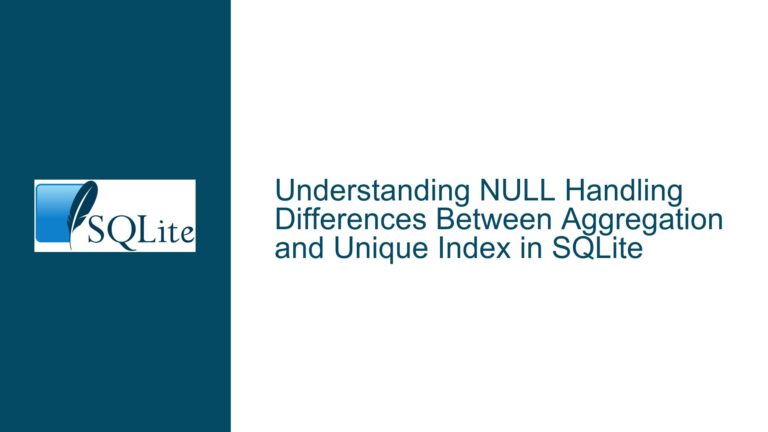Rounding Discrepancies in SQLite’s round(0.15,1) Result
Issue Overview: Binary Representation Limitations and Rounding Behavior
The core issue revolves around the round(0.15,1) function in SQLite returning 0.1 instead of the expected 0.2. This discrepancy arises from the interplay between decimal-to-binary floating-point conversion and the IEEE-754 standard’s limitations. SQLite, like many programming languages and databases, uses IEEE-754 binary64 (double-precision) floating-point numbers to store approximate numeric values. The number 0.15 cannot be represented exactly in binary floating-point format, leading to a value slightly smaller than 0.15 after conversion. When rounded to one decimal place, this approximation results in 0.1.
The confusion stems from differing expectations: users often assume that round() operates on the decimal representation of the input value (i.e., the digits they typed). However, the function works with the binary approximation of that value. For example, the decimal value 0.15 is converted to the binary double 0.1499999999999999944488848768742172978818416595458984375, which rounds down to 0.1 at the first decimal place. Other database systems (e.g., MySQL, PostgreSQL) and programming languages (e.g., Julia, MATLAB) may return 0.2 due to differences in their rounding algorithms or internal numeric representations, such as using decimal arithmetic or heuristic adjustments during rounding.
This issue is not unique to SQLite but is a fundamental challenge in floating-point arithmetic. The problem becomes more pronounced when developers expect deterministic results from operations involving decimal fractions that lack exact binary representations. For instance, values like 0.1, 0.2, and 0.15 are all repeating fractions in binary, leading to tiny rounding errors that propagate through calculations.
Possible Causes: IEEE-754 Artifacts and Algorithmic Choices
Binary Floating-Point Representation:
The root cause is the inability of binary floating-point formats to precisely represent many decimal fractions. The decimal number0.15is a repeating fraction in binary, similar to how1/3is a repeating decimal in base-10. This leads to an approximation that is slightly less than0.15, causinground()to truncate the value downward.Rounding Algorithm Design:
SQLite’sround()function uses a straightforward "round half away from zero" algorithm on the binary representation of the number. This means it does not attempt to infer the original decimal digits or compensate for binary approximation errors. In contrast, some systems (e.g., MATLAB) scale the number by a power of ten, round the result as an integer, and then rescale, which can mask binary approximation issues.Backward Compatibility Constraints:
Changing SQLite’s rounding behavior to align with user expectations could break existing applications that rely on the current behavior. For example, financial applications using SQLite for calculations might have workarounds for the current behavior, and altering it could introduce inconsistencies.Lack of Decimal Arithmetic Support:
SQLite does not natively support decimal arithmetic, which avoids binary approximation errors by representing numbers in base-10. While extensions like thedecimalmodule exist, they are not integrated into core functions likeround().
Troubleshooting Steps, Solutions & Fixes
Step 1: Verify the Binary Representation
To confirm that the input value is being approximated as a binary double, use SQLite’s printf() function to display the full precision of the number:
SELECT printf('%.20f', 0.15); -- Output: 0.14999999999999999445
This reveals that 0.15 is stored as a value slightly less than 0.15, explaining why it rounds down.
Step 2: Use Scaling to Avoid Binary Approximation
Multiply the value by a power of ten to shift the decimal point, round the result as an integer, and then rescale:
SELECT round(0.15 * 10) / 10.0; -- Returns 0.2
This works because 0.15 * 10 = 1.5, which is exactly representable in binary. Rounding 1.5 to the nearest integer yields 2, and dividing by 10 gives 0.2.
Step 3: Leverage the Decimal Extension
Compile SQLite with the decimal extension to enable precise decimal arithmetic. This extension stores numbers as decimal strings, avoiding binary approximation:
SELECT decimal_round('0.15', 1); -- Returns '0.2'
Note that the decimal extension is not enabled by default and requires custom compilation.
Step 4: Implement a Custom Rounding Function
Create a user-defined function (UDF) in SQLite using a language like C, Python, or JavaScript to handle decimal rounding. Below is a Python example using the decimal module:
import sqlite3
from decimal import Decimal, ROUND_HALF_UP
def decimal_round(value, digits):
return float(Decimal(str(value)).quantize(Decimal(f'1e-{digits}'), rounding=ROUND_HALF_UP))
conn = sqlite3.connect(':memory:')
conn.create_function('decimal_round', 2, decimal_round)
cursor = conn.execute('SELECT decimal_round(0.15, 1)')
print(cursor.fetchone()[0]) # Output: 0.2
Step 5: Monitor SQLite Updates for Rounding Improvements
The SQLite development team has explored alternative rounding algorithms, such as the "Herbster method," which accounts for decimal input intent. Track the round-up-2 branch for potential future integration into official releases.
Step 6: Educate Stakeholders on Floating-Point Nuances
Document the limitations of binary floating-point arithmetic for all users interacting with SQLite. Provide examples of safe practices, such as avoiding floating-point for financial calculations and using integer cents instead.
By understanding the interplay between decimal expectations and binary realities, developers can choose the most appropriate strategy to achieve accurate and reliable rounding in SQLite.






